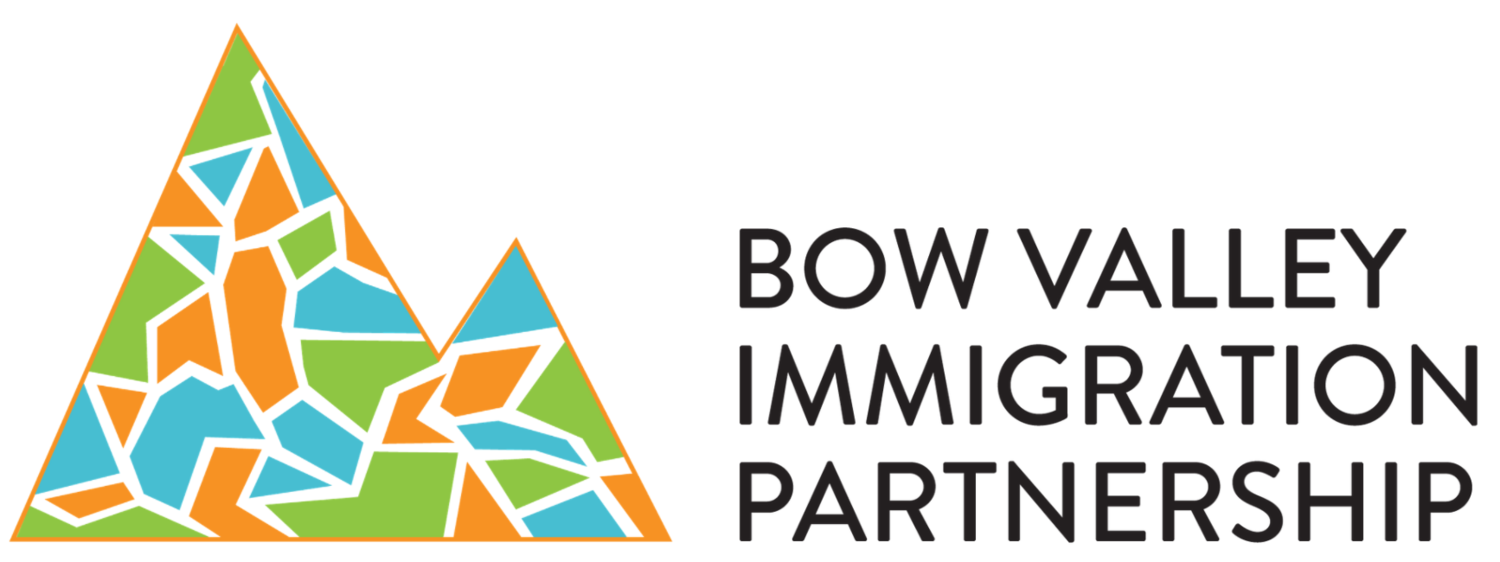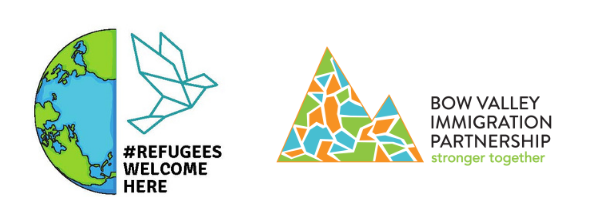Supporting Refugees & Displaced People In The Bow Valley
May 2022: Afghan Refugees, Displaced Ukrainians, and more… what’s happening and how can you help?
We believe the information we are sharing is correct, but refugee situations are complex and changing. We cannot guarantee the accuracy of the information below. Please refer to the Government of Canada website for official information and updates.
Here’s what we know so far.
What’s happening around the world?
At the end of 2020, more than 82.4 million people around the world were forcibly displaced by conflict, persecution, violence, or “events seriously disturbing public order” (UNHCR).
“Today, one per cent of humanity is displaced and there are twice as many forcibly displaced people than in 2011” (learn more about the global refugee crisis: UNHCR Refugee Statistics).
Since February 24th 2022, 7.7 million people have been internally displaced in Ukraine and 5.317 million people have fled Ukraine (International Organization for Migration, April 28, 2022.)
There are 2.6 million registered Afghan refugees around the world (UNHCR). An additional 3.4 million Afghans were displaced within the country by the end of 2021 (UNHCR)
Many Bow Valley organizations and individuals are working together to help displaced people from around the world.
The Bow Valley Immigration Partnership (BVIP) is helping to gather information and coordinate the local response to support Afghan refugees and displaced Ukrainians.
At a glance: Bow Valley support for refugees & people displaced by war
Bow Valley locals come from all over the world and have many immigration statuses. Many people who have been forcibly displaced have now made the Bow Valley home.
The Bow Valley is not usually the first place that displaced people arrive when they land in Canada. Many people first arrive in Calgary, Edmonton, Red Deer, Lethbridge, Medicine Hat, Brooks, Grande Prairie, and Fort McMurray. These are designated Resettlement Assistance Program (RAP) communities, that have extra services to help refugees when they first arrive.
The Bow Valley Refugee Project is a group of volunteers who sponsor refugees to come directly to the Bow Valley.
Some people move to the Bow Valley after first arriving in another city or town. This is called ‘Secondary Migration’.
No matter how people arrive, support is available for displaced people in the Bow Valley.
Settlement Services in the Bow Valley is the key contact for refugees and sponsors of refugees. Settlement Services in the Bow Valley offers free, confidential, quality support for newcomers and helps people connect with other services and opportunities to meet their unique needs.
Groups and organizations like Settlement Services in the Bow Valley, Bow Valley Refugee Project, Bow Valley Learning Council, municipal Community Services departments, and many more work together to plan supports.
People who have been displaced are neighbours, leaders, colleagues, creators, friends, community builders, citizens, and contributors.
How can locals help?
Here’s what residents in Banff, Canmore, Lake Louise, or Kananaskis can do to support refugees and people displaced by war:
Stay up-to-date and learn about upcoming local settlement support activities
Refer any refugees you know to free support services
Donate:
AfghanResettlement.ca (Calgary Catholic Immigration Society)
Support Afghan Refugees (Centre for Newcomers, Calgary)
Volunteer:
Settlement organizations leading front line responses in Alberta:
Calgary Catholic Immigration Society (CCIS) (Calgary & southern Alberta)
Centre for Newcomers (Calgary)
Catholic Social Services (Edmonton, Red Deer, & Lloydminster)
Offer housing or non-monetary donations:
Bow Valley Refugee Project Bow Valley Refugee Project is actively seeking accommodation in the Bow Valley that may be suitable for displaced Ukrainians.
Hire, support, and retain newcomer staff:
Participate in the Bow Valley Workplace Inclusion Charter program
Organizations that want to support Afghan refugees or displaced Ukrainains with employment should connect with the Job Resource Center (JRC). Job offers should include suitable staff accommodation. Contact the JRC to learn more.
Support the #RefugeesWelcomeHere campaign.
Afghan refugee resettlement
The Canadian Government has promised to welcome 40,000 Afghan refugees to Canada.
As of April 8th, over 10,600 Afghan refugees have arrived in Canada.
Calgary and Toronto are the two ports of entry.
It could take 2 years to complete Canada’s current Afghan refugee resettlement effort.
There are 3 special immigration programs for Afghan refugees. Canadian residents can also privately sponsor Afghan refugees, but it has been difficult for many Afghan people to get proof of their refugee status (United Nations Refugee Status).
Over 5,000 Afghan refugees have arrived in Calgary and more are expected in the coming months.
Most Afghan refugee arrivals have been family groups.
Some Afghan refugees will stay in Calgary, but many have moved or will move to other Resettlement Assistance Program (RAP) communities across western Canada. There are 8 RAP communities in Alberta.
Some people will also move to non-RAP communities like the Bow Valley by secondary migration. BVIP members are working with partners in RAP communities to prepare for secondary migration.
Ukrainians displaced by war
Since February 24th, 2022, 7.7 million people have been internally displaced in Ukraine and 5.317 million people have fled Ukraine (International Organization for Migration, April 28).
There are special Ukrainian immigration measures, including Temporary Resident Visas (TRV) through the Canada-Ukraine Authorization for Emergency Travel (CUAET) program. TRV holders can apply for 3-year work permits.
Canada has received over 133,000 Ukrainian TRV applications and approved 42,000. Around 200-300 Ukrainians are arriving in Canada each day. (Source: Operation Ukrainian Safe Haven updates via National Local Immigration Partnership Secretariat. We’ll update these numbers as we learn more.)
While displaced Ukrainians are not considered refugees, they can access many of the same government supports as refugees and Permanent Residents of Canada (PR), as soon as they arrive here.
Many Ukrainian arrivals so far have been family groups of women, children, and seniors.
Many have existing connections in Canada, and so far, most Ukrainian arrivals in Alberta have settled where they have existing family connections.
Newly announced supports including chartered flights, income and housing support, and wider resettlement efforts might mean the Bow Valley could welcome more displaced Ukrainians.
This is an important time for the Bow Valley to work together as a community so that all arrivals can settle in, and live their best lives here.
Challenges & Opportunities
Across the country, housing is the biggest resettlement challenge, and this is also true in the Bow Valley, especially for families. Many Afghan and Ukrainian arrivals are families.
Refugees and displaced people face the same challenges as all Bow Valley locals (for example, affordability, access to a family doctor, foreign credential recognition, and access to diverse prayer spaces).
Additional factors like language, culture, and trauma can make resettlement a challenging journey.
The Bow Valley does not have as many multilingual and specialized settlement services as larger centres, however, we do have:
Plenty of job opportunities
English language classes for all levels
Settlement and other support services
Experienced volunteer groups including
Ethnocultural associations
Faith communities
Bow Valley Refugee Project
Practice and a good system for working together
Experience welcoming secondary migrants
What’s Next?
A small number of Afghan refugees and displaced Ukrainians are already resettling in the Bow Valley. Local people and organizations are helping them to make the Bow Valley their second home.
We may see more arrivals through ‘secondary migration’ - when a refugee decides to move from the first place they were resettled to a different host community.
Currently, many newly arrived displaced people are living in temporary housing in a few cities and towns in Alberta. We believe that with planning and collaboration we can help some of those people make the Bow Valley their home.
We’re working with local and regional partners on a plan to support secondary migration that is successful for individuals, employers, and our communities.
We’re gathering information via the National Local Immigration Partnership Secretariat and the Alberta Association of Immigrant Serving Agencies (AAISA) and will continue to share updates with member organizations and the public as new information becomes available.
Support the #RefugeesWelcomeHere campaign.
For refugees to settle into the Bow Valley quickly and successfully, it’s critical to connect with professional support services as soon as possible.
Free, professional, qualified, appropriate, and confidential support is available for refugees, displaced people, Permanent Residents of Canada, Foreign Workers, and other newcomers in the Bow Valley. Newcomers can get help with:
English classes
Parenting and schooling
Free and low-cost activities and resources
Making friends
Housing
Work
Schooling
Taxes
Adjusting to life in Canada
The first step for any refugees arriving in the Bow Valley is to connect with Settlement Services in the Bow Valley.
A connection to a formal supporting agency opens doors to more local supports so refugees can settle in and live their best lives here in the Bow Valley. Please refer any refugees you know to Settlement Services.
Local settlement supports everyone should know
Settlement Services in the Bow Valley offers free support for all Permanent Residents of Canada (PR), PR applicants, and refugees.
They regularly host free activities and information sessions and can help with questions about housing, English classes, making friends, taxes, Citizenship, parenting, school, free local resources, and more.
Website: banff.ca/settlement
Foreign Worker Support Service from Calgary Catholic Immigration Society (CCIS) offers free support for people with Canadian work permits.
Learn about work permits and visas, employment rights and responsibilities, becoming a permanent resident, wildlife safety, community integration, help with documents and more.
Website: banff.ca/tfw
Bow Valley Learning Council offers Affordable adult learning classes including English classes for all levels.
First stop for all English language learning needs and opportunities.
Website: bowvalleylearning.ca
Bow Valley College offers many options to learn and improve skills, including free English classes for Permanent residents
The ‘Language Instruction for Newcomers' to Canada’ program provides free English classes for Permanent Residents of Canada.
Website: bowvalleycollege.ca
Bow Valley Refugee Project is a group of local residents working collectively to sponsor refugee families to settle in the Bow Valley.
Since 2016, they have sponsored two families, who are now living in, and contributing to, our community.
Bow Valley Refugee Project is preparing for the arrival of five additional sponsored refugees.
Website: bowvalleyrefugee.ca












